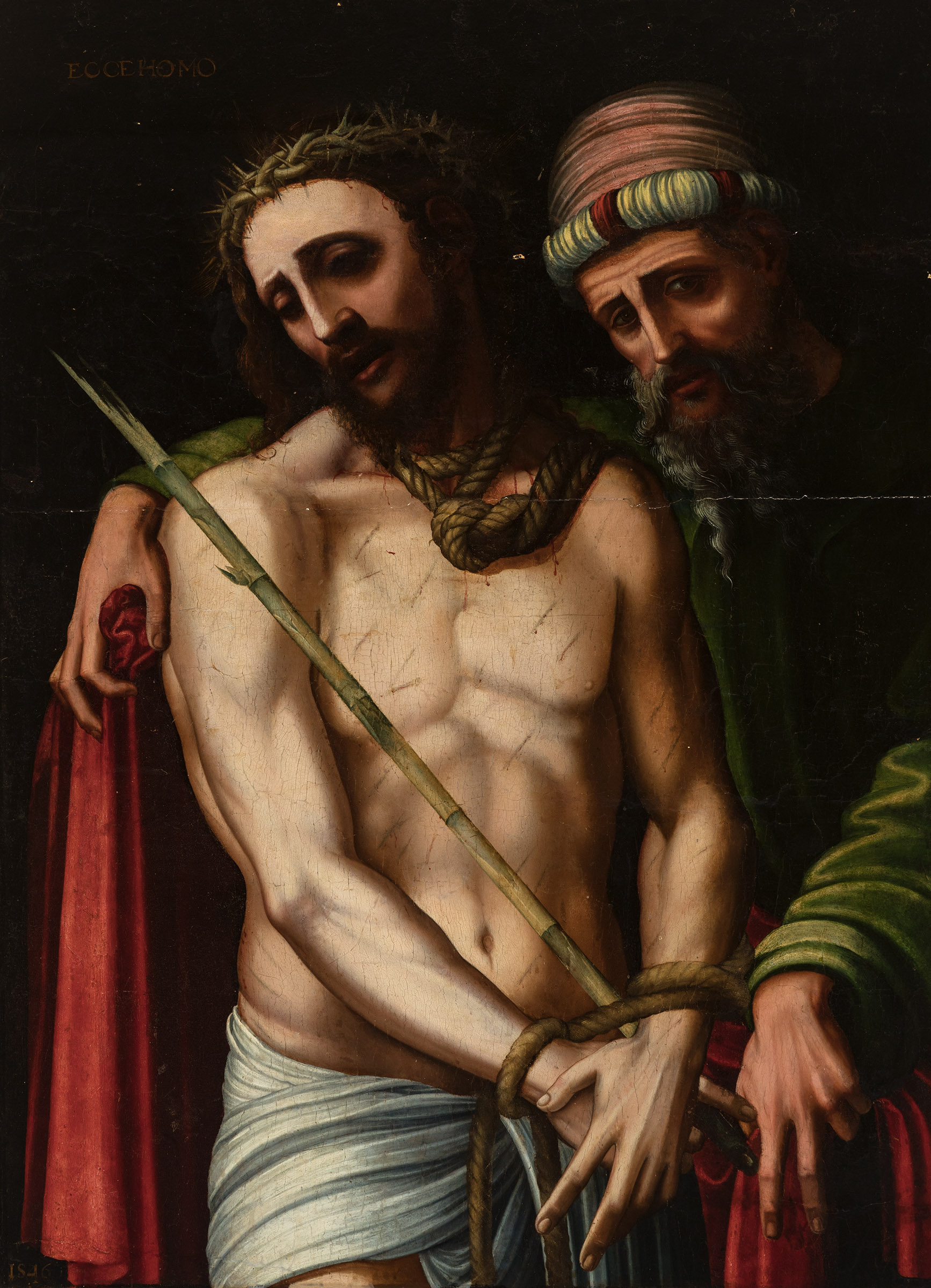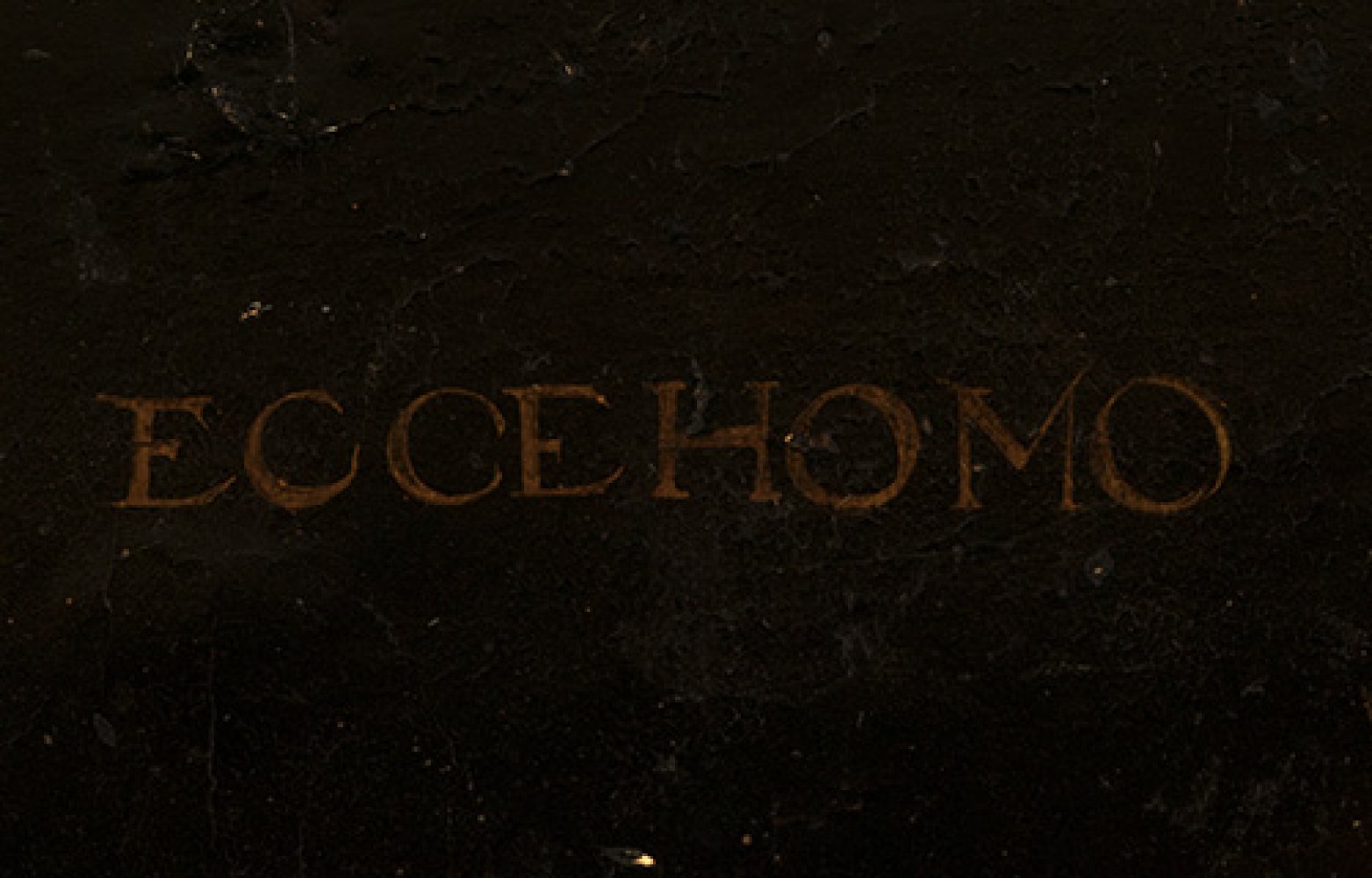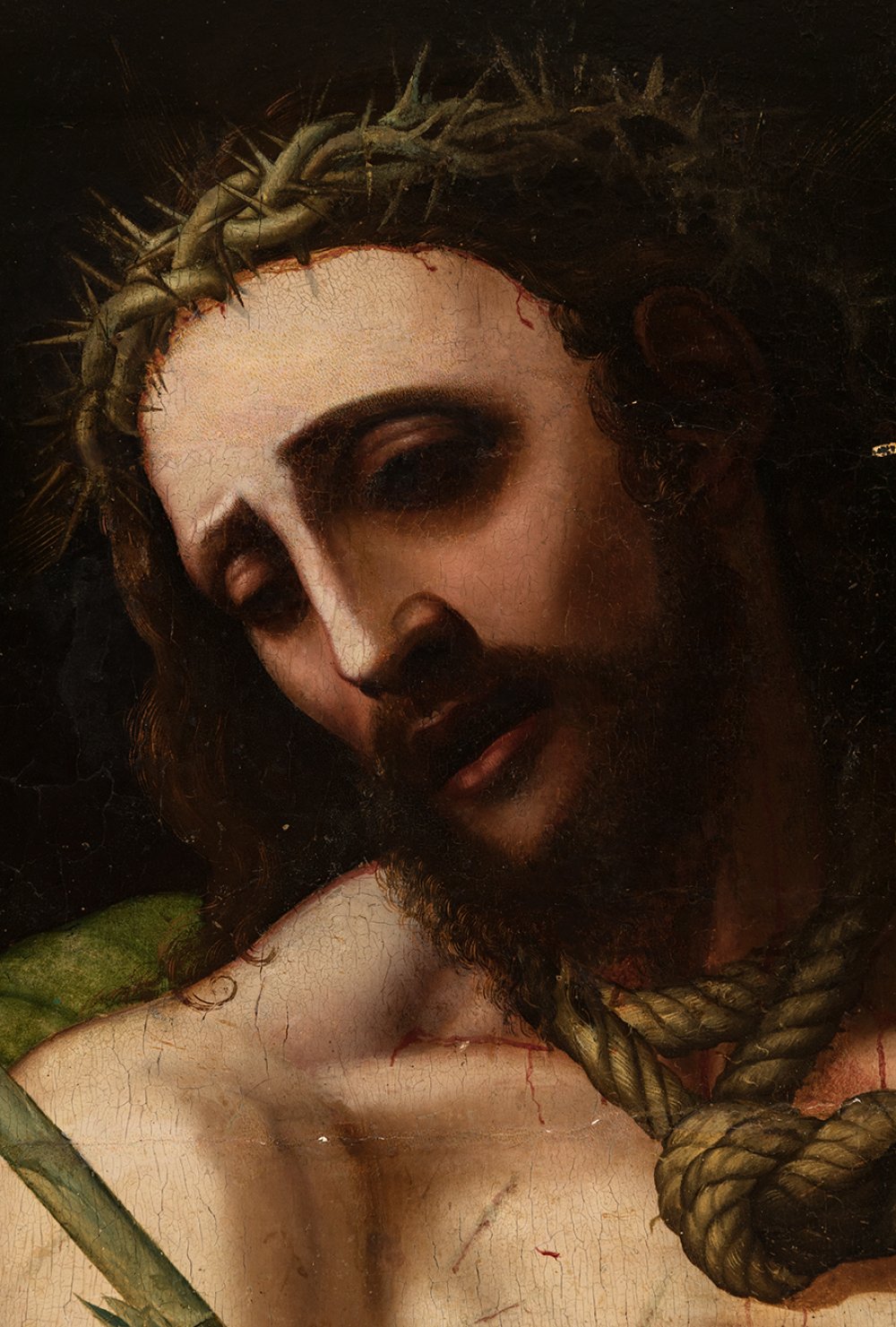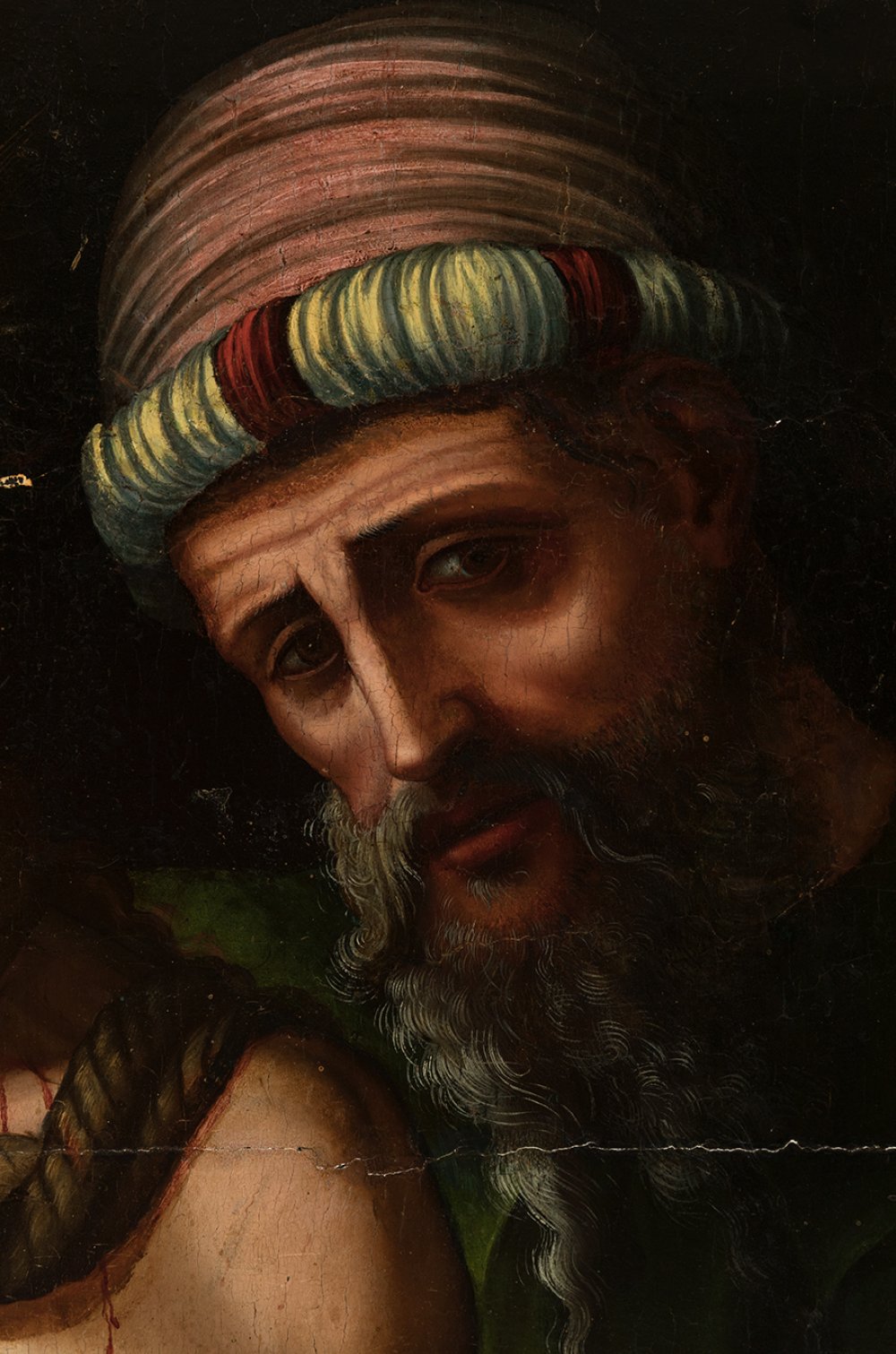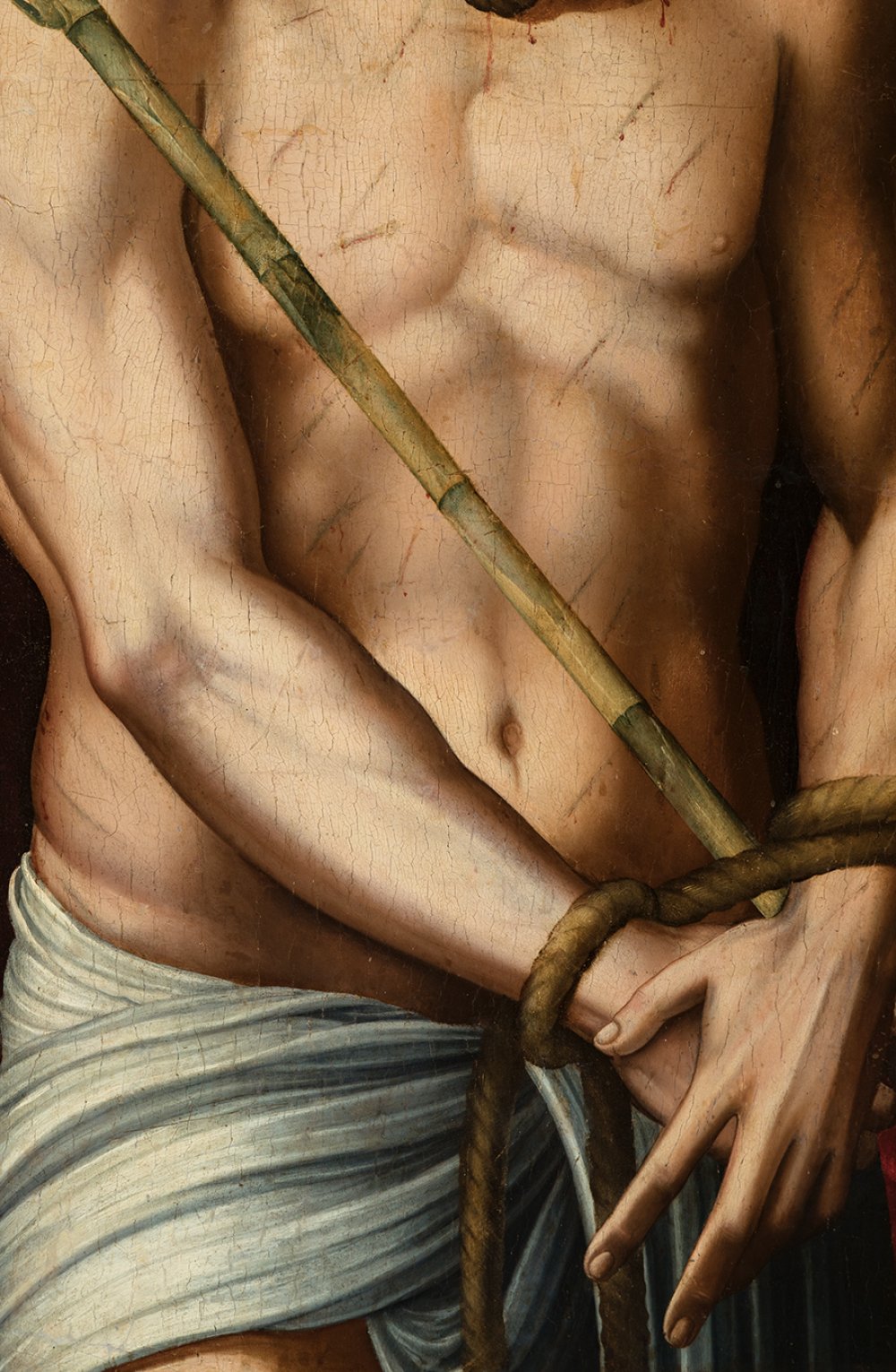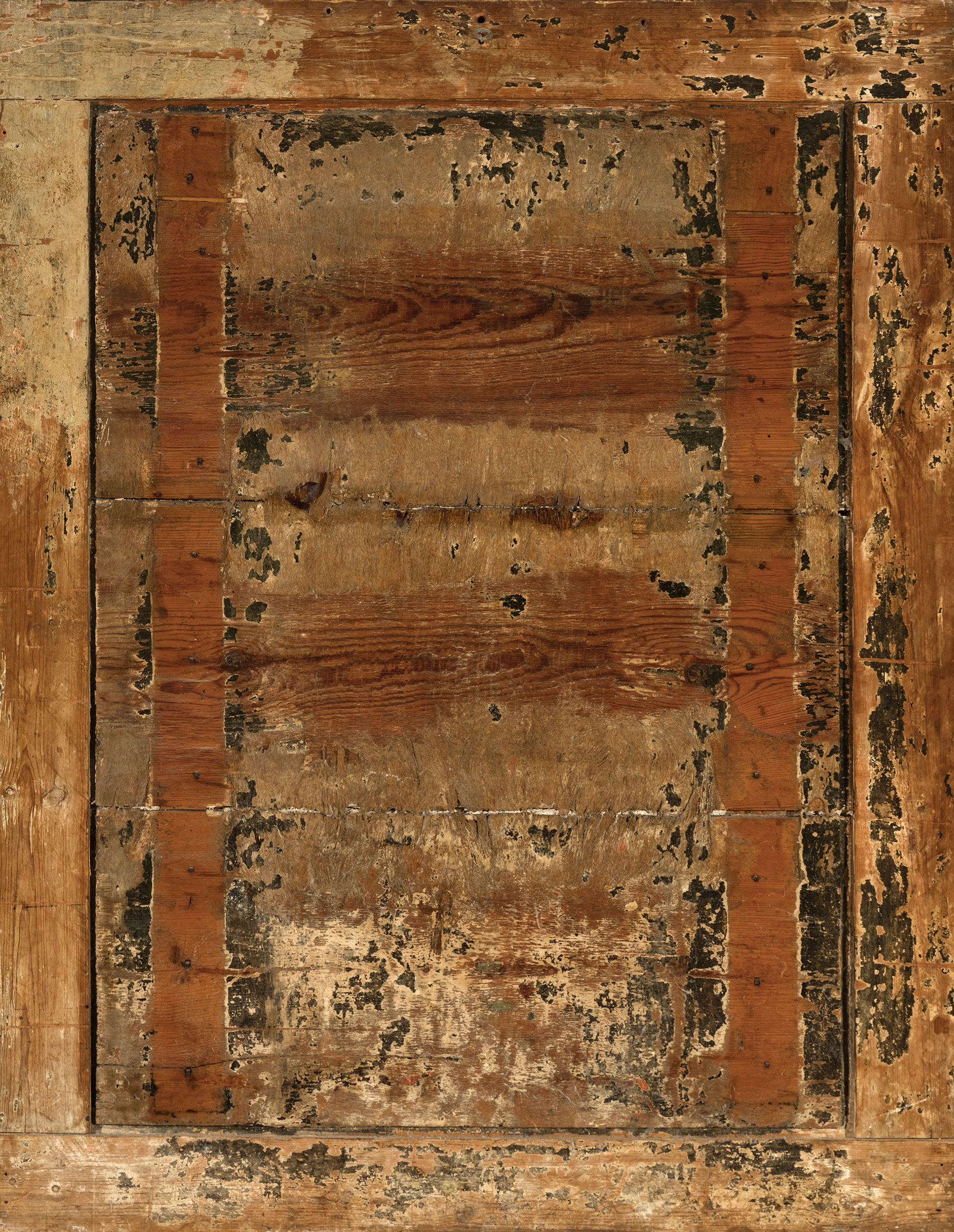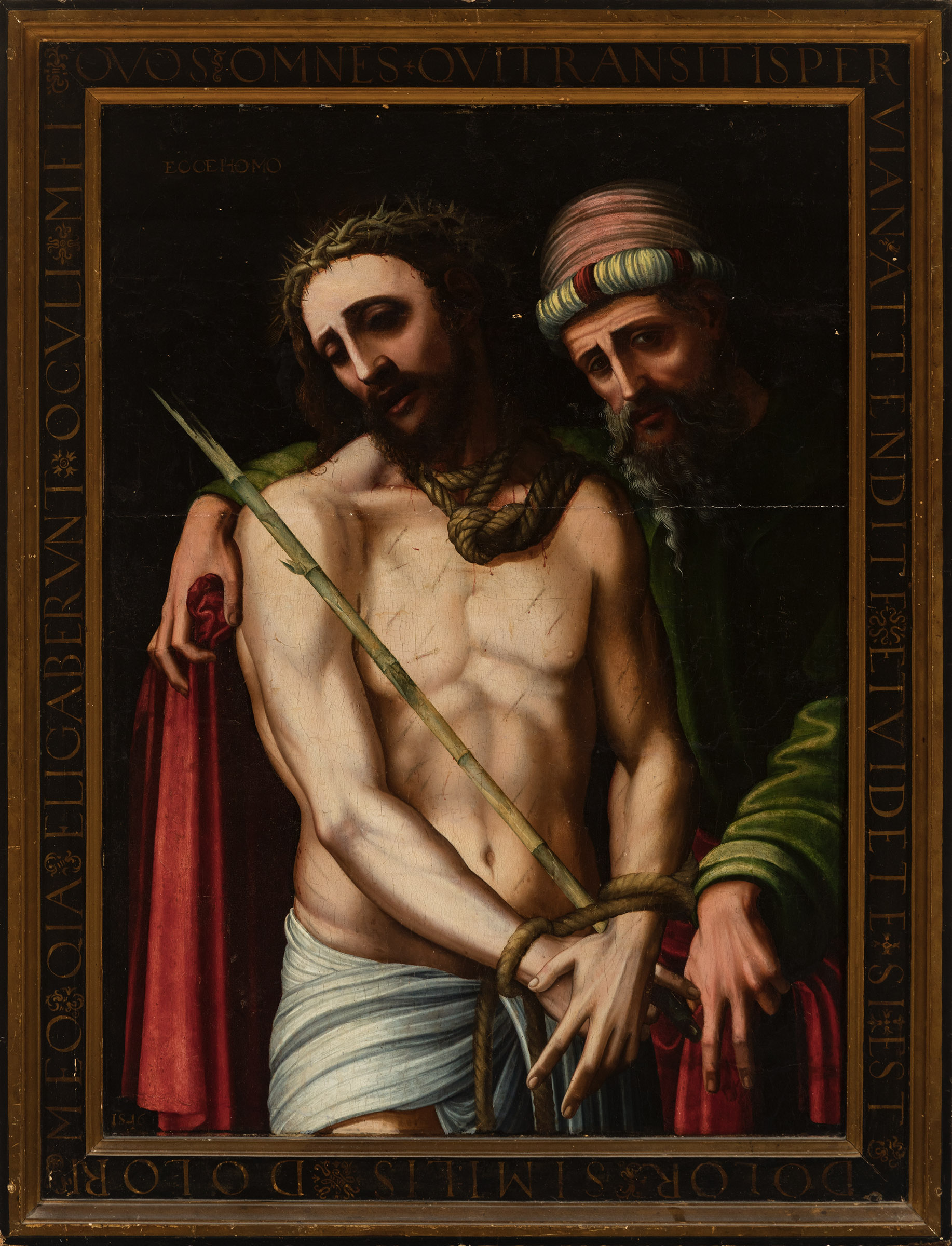48
Spanish school; circa 1546."Eco homo".Oil on panel.Size: 98 x 70 cm, 119 x 92 cm (frame).The
"Eco homo".
Oil on panel.
Size: 98 x 70 cm, 119 x 92 cm (frame).
The author of this devotional work conceives the theme of the Ecce Homo, through the use of a simple and clear composition, with the long bust of Christ in the foreground and the figure of Pontius Pilate behind him, supporting his body on Jesus. The absence of narrative details in the dark background that closes the scene enhances the expressive power and pathos, designed to move the spirit of the faithful who pray before the image, in a tremendist sense very typical of Catholic countries. Visually, the lighting treatment dominates, very contrasting and effective, based on a spotlight that falls directly on the figure of Christ, creating expressive effects, and leaving the rest in semi-darkness, against a dark, neutral background that further enhances the physical presence of the figure. The colour scheme is also based on a restrained, warm palette of ochre, earthy and carmine tones. Technically speaking, it should be noted that during the 16th century the influence of the Flemish school of painting was a key factor in the development of European art, especially in Spain, which was linked to the Low Countries by political and economic ties. At that time, Flemish painters established a stylistic model based on the search for reality, focusing on capturing the qualities of objects, giving special importance to secondary details and using a smooth, draughtsmanlike technique. In the 16th century, as a result of the introduction of the novelties of the Italian Renaissance, the Flemish style evolved towards a more classical and sculptural sense, while retaining its own characteristics. This change also affected the Hispano-Flemish school, which also had independent channels for the penetration of the Italian style. Influences mainly came to Spain from Raphael and his followers, through engravings, oil paintings and painters who travelled between the two countries.
The theme of Ecce Homo belongs to the Passion cycle and immediately precedes the episode of the Crucifixion. Following this iconography, Jesus is presented at the moment when the soldiers mock him, after crowning him with thorns, dressing him in a purple tunic (here red, the symbolic colour of the Passion) and placing a reed in his hand, kneeling down and exclaiming "Hail, King of the Jews". The words "Ecce Homo" are those pronounced by Pilate when presenting Christ to the crowd; their translation is "behold the man", a phrase by which he mocks Jesus and implies that Christ's power was no match for that of the rulers who were judging him there.
"Eco homo".
Oil on panel.
Size: 98 x 70 cm, 119 x 92 cm (frame).
The author of this devotional work conceives the theme of the Ecce Homo, through the use of a simple and clear composition, with the long bust of Christ in the foreground and the figure of Pontius Pilate behind him, supporting his body on Jesus. The absence of narrative details in the dark background that closes the scene enhances the expressive power and pathos, designed to move the spirit of the faithful who pray before the image, in a tremendist sense very typical of Catholic countries. Visually, the lighting treatment dominates, very contrasting and effective, based on a spotlight that falls directly on the figure of Christ, creating expressive effects, and leaving the rest in semi-darkness, against a dark, neutral background that further enhances the physical presence of the figure. The colour scheme is also based on a restrained, warm palette of ochre, earthy and carmine tones. Technically speaking, it should be noted that during the 16th century the influence of the Flemish school of painting was a key factor in the development of European art, especially in Spain, which was linked to the Low Countries by political and economic ties. At that time, Flemish painters established a stylistic model based on the search for reality, focusing on capturing the qualities of objects, giving special importance to secondary details and using a smooth, draughtsmanlike technique. In the 16th century, as a result of the introduction of the novelties of the Italian Renaissance, the Flemish style evolved towards a more classical and sculptural sense, while retaining its own characteristics. This change also affected the Hispano-Flemish school, which also had independent channels for the penetration of the Italian style. Influences mainly came to Spain from Raphael and his followers, through engravings, oil paintings and painters who travelled between the two countries.
The theme of Ecce Homo belongs to the Passion cycle and immediately precedes the episode of the Crucifixion. Following this iconography, Jesus is presented at the moment when the soldiers mock him, after crowning him with thorns, dressing him in a purple tunic (here red, the symbolic colour of the Passion) and placing a reed in his hand, kneeling down and exclaiming "Hail, King of the Jews". The words "Ecce Homo" are those pronounced by Pilate when presenting Christ to the crowd; their translation is "behold the man", a phrase by which he mocks Jesus and implies that Christ's power was no match for that of the rulers who were judging him there.
9th November - Old Masters
Sale Date(s)
Venue Address
General delivery information available from the auctioneer
Setdart offers Worldwide shipping
PICK UP IN ROOM: You can come and pick up your lots in our offices (Barcelona, Madrid or Valencia). At the moment of the withdrawal, you will be able to accept the current conditions of the lot by means of a document that you will sign.
YOU CAN SEND ANOTHER PERSON TO PICK UP: This person must present a signed authorization that you can find in our web page by accessing from BUY AT SETDART- LOGISTICS-DOWNLOAD AUTHORIZATION DOCUMENT. You can also send an e-mail with the requested data in AUTHORIZATION DOCUMENT to admin@setdart.com
Important Information
25% buyer´s premium
OR
21% buyer´s premium at www.setdart.com
Terms & Conditions
The maximum period to pay the lots is 7 working days. You can pay either via bank transfer or with credit card through our platform www.setdart.com (we only accept VISA or Mastercard).
BUYER´S PREMIUM: 22% Hammer price + 21% VAT from the buyer´s premium
If your piece has more than 100 years, our Ministry of Culture requires an export certificate in order for the piece to leave the country. Note that if the piece goes inside the EU, there is no cost for the export certificate. If the piece goes outside the EU, there is a cost for the export certificate. You can find more information in our Ministry of Culture website: https://www.culturaydeporte.gob.es/en/cultura/patrimonio/exportacionimportacion/exportacion/tasas.html
INQUIRIES: admin@setdart.com
Setdart guides you through the entire process, from the time of award to the day you receive your lot. Our logistics team will be happy to manage your transport, and will advise you on the best shipping method with professionals from the sector used to handling works of art and jewelry.
WE OFFER WORLDWIDE DOOR TO DOOR SHIPPING
PICK UP IN ROOM: You can come and pick up your lots in our offices. At the moment of the withdrawal, you will be able to accept the current conditions of the lot by means of a document that you will sign.
YOU CAN SEND ANOTHER PERSON TO PICK UP: This person must present a signed authorization that you can find in our web page by accessing from BUY AT SETDART-LOGISTICS-DOWNLOAD AUTHORIZATION DOCUMENT. You can also send an e-mail with the requested data in AUTHORIZATION DOCUMENT to admin@setdart.com
SETDART IS NOT RESPONSIBLE FOR THE STATE OF THE PARTS ONCE THEY LEAVE OUR FACILITIES. MRW SHIPMENTS: Once the payment is made, your lot will be packed for shipment, the logistics department will send you an e-mail notifying you of the day it leaves our warehouse, changes of address cannot be made after receiving this e-mail.
INSURANCE INCIDENTS: Coverage for the value of the auction up to 3000 ? per shipment, if the value of the auction is higher, Setdart will send you a quote including the additional insurance. The insurance company WILL NOT BE RESPONSIBLE FOR THE SHIPMENT THAT EXCEEDS THAT AMOUNT AND IS NOT FULLY INSURED. MRW INCIDENTS: Maximum notification 48 hours after receipt, after which the insurance company WILL NOT BE RESPONSIBLE AND NO CLAIMS WILL BE ACCEPTED.
E-MAIL LOGISTICS: logistica@setdart.com
PICK UP YOUR MESSAGES: You can send your own messaging, prior notice via e-mail that your shipment is ready, please note 3 or 4 days in advance. This type of shipment is packaged so Setdart will provide you with a quote.
EXPENSES FOR STORAGE: We inform you that if the purchased lot is not picked up within a month, you will be charged 30€ per week per lot. Setdart Online S.L., owner of the web site "setdart.com", "setdart.net" and "setdart.org", acts as a company of Spanish nationality inscribed in the Volume 36955, sheet 182, page B-293056 of the Mercantile Registry, with registered office at Calle Aragó















